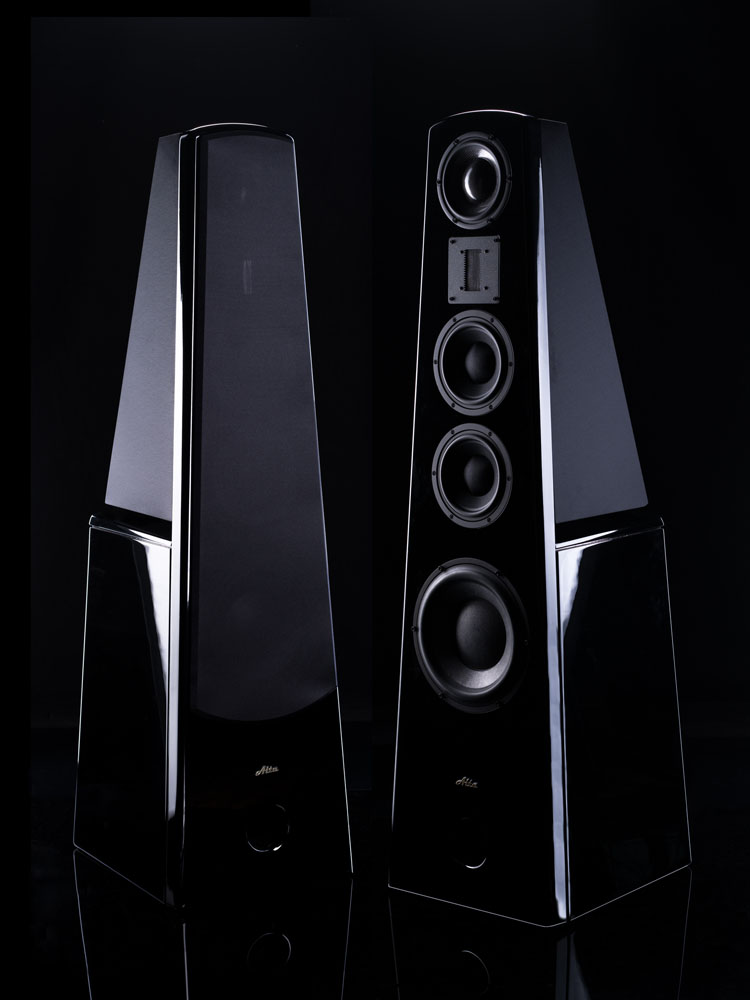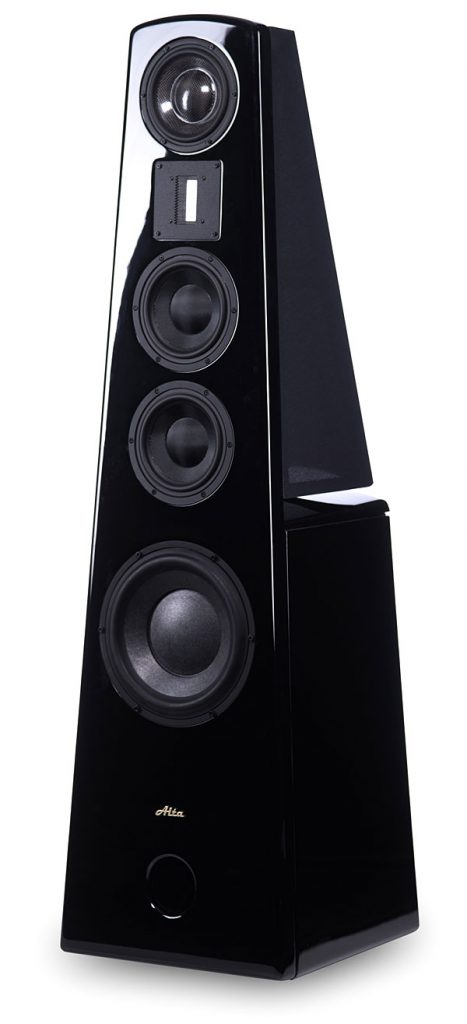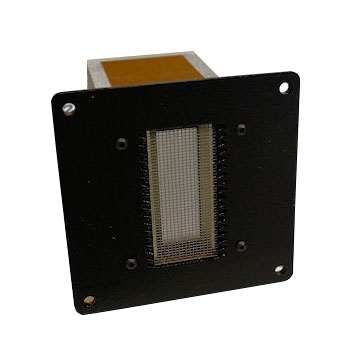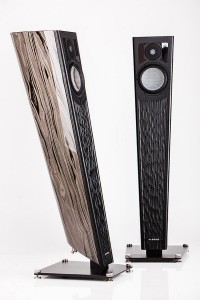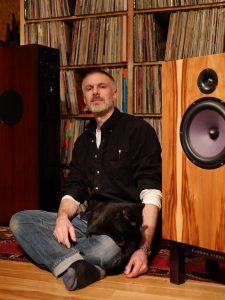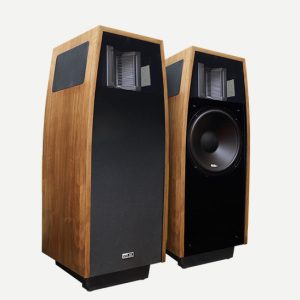Founded in 2013, Alta Audio is the creation of long-time industry presence Michael Levy. Alta's first speaker, the Celesta FRM-2, came about as a result of encouragement from his good friend and client, reviewer Martin Appel. With the support from those he respected, Michael was convinced he could develop a great line of speakers that would reflect his deep passion for music. A select group of beta testers conducted exhaustive listening sessions over a very long period of time. With the input of his trusted advisers, Alta's new creation began to take shape. After much tweaking and improvement, the Hestia Titanium was born.
Michael's passion was on full display when we played the first tracks after set up. His encyclopedic knowledge of all things Joni Mitchell, for instance, made for some great listening and discussion. Punctuated by animated displays of sincere human emotion, I quickly got the impression Mr. Levy has a deep well of musical knowledge and a driving passion from which to draw. I believe these qualities are deeply embedded in the DNA of the Hestia Titanium and likely within every product in the Alta range.
The Hestia Titanium is no average been there-done that "me too" design. The bass section is a hybrid system that combines the best features of a ported design with the best features of transmission line designs, dubbed XTL. Ported designs tune to the parameters of the driver and cabinet coupling from the system's resonant frequency and up, with excellent control when properly tuned, but are uncontrolled below resonance. Transmission line designs couple at the resonant frequency and below, extending the response and control of the system at least on half octave. XTL bass tuning uses both systems to increase overall dynamics and control while extending bass response.
Titanium formers are used in all of the dynamic drivers in the Hestia, because titanium is extremely light and stiff, and resists the migration of electrons on the former. Aluminum formers, which are the standard, allow the migration of electrons which creates a hysteresis loop that impedes the dynamic response of the driver. Using titanium cures this problem.
The Hestia Titanium drivers are in what Alta calls a "Dipolito" configuration. In a D'Appolito configuration a midrange is placed above and below the tweeter to create a unified wide band pulse response that most closely mimics the original sound pulse. In that configuration there are two 7 inch midranges below and one 6 inch midrange above the ribbon tweeter. In the crossover passband with the tweeter, the output of the two lower midranges matches the output of the single 6 inch midrange above the tweeter, thus creating a unified pulse, but in the woofer crossover passband the two 7 inch lower midranges have the extended lower midrange and bass response needed to meld seamlessly into the woofer. All three midranges are also in a dipole open baffle configuration. A dipole mimics the original sound waves because the rear waves are reversed in phase to the front waves. This setup gives a larger more palpable feeling of stage size with the higher midrange driver casting images realistically high and clear. Blending in the pinpoint accuracy of the monopole ribbon tweeter keeps the individual images from becoming diffuse or bloated and lays them out realistically on the sound stage.
A proprietary material they call DampHard is a multi-layered, multi-density material that makes up the walls of the speaker cabinets. Where standard MDF or other materials would allow certain frequencies to resonate the cabinet, DampHard remains dead to virtually all vibration. This allows Alta to heavily cut down on a cabinet's internal padding, maintaining the clarity of the bass. Coupled with the Alta XTL technology, DampHard allows them to create a truly superior cabinet that acts like a musical instrument, extending the range and clarity of the bass, while keeping the cabinet resonance-free.
We placed the 54" tall Hestia Titanium roughly 10' apart along the long wall in my 33' x 60' x 14' listening space, and 7' from the front wall. We soon realized my reference MIT AC167 speaker wire and jumpers spades would not fit into the European spec plastic covered speaker terminals. Luckily I had an old pair of Cardas bi-wire handy to get things going.
The McIntosh MB50 streamer and the outstanding VPI Avenger Reference turntable fed the D'Agostino Momentum preamplifier and phono stage, and the Hestia Titaniums were driven with great confidence by the 200-watt Class A PassLabs XA 200.5 Mono blocks. The sound was at once disarming, tonally complete and incredibly involving.
Pulling the lens back a bit to offer my view of speakers writ large, a few points. It is very difficult to create a speaker that speaks with a single voice as the Hestia Titanium does. Large full-range planars and electrostatics can do it well due to the lack of crossover from driver to driver. But with the limited excursion depth of a full range panel, they simply can't move the air necessary to reach high Spls without distortion, save a few of the much larger designs. Looking at the bantam weight Hestia with its dipole mid range custom spec ribbon tweeter, dual upper/lower mid band drivers and single 10" bass driver, you may not be prepared for how loud and deep they can go without a hint of distortion. The Hestia does this while maintaining the seamless blend of the drivers in the process. There are far fewer speakers that can pull this trick off than one may think, regardless of price. Once heard, it re-calibrates the expectations and can ruin the experience of lesser designs. My large room always weeds out the weaklings and the Hestia quickly retired any misgivings I may have had at first glance.
The enormous $50K 600lb. Sunny Majestic15s fill the room like no other speaker I've had, but lacks the coherence from driver to driver of the Hestia Titanium. The gorgeous sounding and looking $55K Lansche 4.1, with its powered sub section and Plasma tweeter, cannot keep up with the Hestia dynamically through the mid band and treble, though within its limits there is nothing like a plasma tweeter. Coherence from driver to driver is fundamental to great speaker performance and Michael Levy has clearly done his homework getting the absolute most out of his design. It plays much bigger than its size would imply, and always speaks with a seamless voice.
The Hestia Titanium is a mid range performance monster. That is not to say it favors the mid range through some tonal imbalance or enhancement. From song to song the Hestia Titanium simply lays bare the recording's inherent balance whether Cowboy Junkies Lay it Down, with its dense mix, or lighter more open fare such as Damien Rice O. The Hestia resolves and projects the mid band with such clarity and ease highlighting the songs musicality while minimizing the sense of compression, or choking off of the harmonic structures of instruments. Not only is the mid band fleshed out, it is loaded with dynamic dexterity and delicacy that only enhances and completes the reproduction. The midrange is wide open, ripe with color and texture, and flows dynamically with great ease. Moving up into the treble and down into the bass is seamless and finally integrated form the mid range heart of the Hestia Titanium. The brain is never forced to put the pieces together in any way.
The high frequency performance of the Hestia Titanium is outstanding. The mid band hands off the signal at 2.25kHz to the ribbon tweeter, and the blend of the mid range and treble is totally seamless and perfectly integrated. The ribbon is very dynamic with great power handling. It is also etch, glare, grit, zing, and as distortion free as I've heard, very nearly on par with the Lansche Plasma tweeter. But unlike the plasma tweeter, the ribbon will go louder and will not need to be replaced every 5-600 hours, and at a pretty steep cost. Tonal color is really well served here and is extremely realistic. Cymbals in particular are densely populated with tons of detail and harmonic richness. More often than not you get one of these qualities while sacrificing the other, not here. Violins upper reaches, when well recorded, remain sweet and non fatiguing even when played aggressively, much like a live violin.
Once I received Mike Powell's Verastarr Statement II silver foil speaker wire, power cords, and his reference interconnects, the slight plummy-ness in the bass I was hearing was eradicated; the bass became faster and more neutral with better control, and offered greater reach. I'm not a reviewer that will excuse the lack of a bottom octave in a 30K+ speaker, never have, never will. The Hestia Titanium is not crazy damped bordering on over damped in the way the 70K Sonus Faber Lilium was for instance. There is warmth without overt coloration and boldness without being over bearing. There is great transient definition allowing the lowest notes of Stanley Clarke's What if I Forget the Champagne from East Riverside Drive to shift and transition clearly, and with excellent pitch definition that is often obscured. There is also a nice sense of air and resonance within the timbre avoiding a homogenizing of these shuddering bass tones. Again, looking at the Hestia Titanium you would not think it could unload such deep controlled bass, but it does and does it very well.
The imaging and sound staging of the Hestia Titanium is as good as I have heard in my room. It's vivid and well resolved, yet the smooth mid band and treble provide great contrast to the dead silent background, allowing images to really pop into focus. Not as laid back as the Lansche 4.1, or as forward as the Sonus Faber Lilium, they most resemble the GoldenEar Triton Reference in soundstage perspective. The depth is excellent, and left to right width is limited to how wide the speakers are placed and the quality of the source material. The dipole mid band calls no attention to itself, but would appear to help resolve and untangle densely recorded compositions while adding a nice rendition of air and space when present on the recording. While precise, they were not as laser focused as the more than twice the price Lilium. There is a slight rounding to the outlines which sounds very natural and convincing with the Hestia Titanium. Here the Hestia Titanium and the 55K Lansche have much in common. Both present music in a way that very slightly de-emphasizes outlines in favor of a fleshier, dimensional image. Or perhaps they are simply rendering what the signal is presenting? Either way, this is hardly a criticism and is a quality that I much prefer.
My only knock on the Hestia Titanium is that it looks a tad dated. There are no exotic materials such as carbon fiber or precious veneers to be seen. No glowing back lit logos or contrasting elements to catch the eye. And it comes standard in two colors…as long as one of them is black, Onyx black to be exact (any color can be custom ordered). I dig a little flash, but many don't care one way or the other and I understand that. Over all the build quality is very good, and the looks are handsome, but at the asking price of 32k I would prefer just a little more panache. Yet for a super speaker, which I consider the Hestia Titanium to be, its small foot print will make them easy to integrate in many smaller rooms. One cool add on available are footers machined by VPI. These snappy looking heavy duty supports are the same that are featured on VPI's higher end turntables, and can be added for an additional cost of 3K.
Conclusion
Mike Levy and his company Alta Audio have created an amazing sounding product with the Hestia Titanium. Hestia is the Greek Goddess of architecture and home. This is fitting, as the Hestia Titanium convincingly presents and anchors the architecture of music in your home. Having listened to more speakers than I can count, I could hear the "it" factor immediately. There is a freedom of expression, a dexterity and lack of compression that allows music to fly free from the drivers, making other speakers, even really good ones, sound like they are a tad choked off. There is no added grain, etch, or other commonly disdained distortion to be found on the top end, no boomy-ness, over damping, or muddling of the bass frequencies. Music simply "happens" through the Hestia Titanium with no attention called to the speaker itself. Until you decide to look to the left or the right, and force yourself to focus on the fact that the two multi-driver festooned lacquered structures are part of the process, you simply forget they are there. As a music lover that's exactly what I want in a speaker, to utterly forget them while they are playing and as a reviewer to vividly and lovingly remember them when they are gone.
Hestia Titanium Loudspeakers
Retail: $32,000 a pair
Alta Audio




